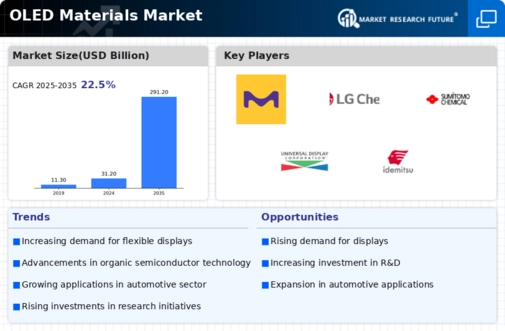Market Growth Projections
The Global OLED Materials Market Industry is poised for remarkable growth, with projections indicating a market value of 31.2 USD Billion in 2024 and an anticipated increase to 291.2 USD Billion by 2035. This growth trajectory suggests a compound annual growth rate (CAGR) of 22.5% from 2025 to 2035. The increasing demand for OLED displays across various sectors, including consumer electronics, automotive, and smart home technologies, is expected to drive this expansion. As manufacturers continue to innovate and improve OLED materials, the market is likely to witness significant advancements and opportunities.
Expansion of Smart Home Technologies
The rise of smart home technologies is contributing to the growth of the Global OLED Materials Market Industry. As consumers increasingly adopt smart devices, the demand for high-quality displays in home automation systems is on the rise. OLED technology offers superior visual experiences, making it ideal for smart home applications such as smart mirrors and interactive displays. This trend is likely to drive the demand for OLED materials, as manufacturers seek to incorporate advanced display technologies into their products. The expansion of smart home technologies may lead to a notable increase in market value in the coming years.
Sustainability and Energy Efficiency
Sustainability concerns are influencing the Global OLED Materials Market Industry, as consumers and manufacturers prioritize energy-efficient technologies. OLED displays consume less power compared to traditional LCDs, making them an attractive option for environmentally conscious consumers. This shift towards sustainable materials aligns with global efforts to reduce carbon footprints and promote eco-friendly products. As the demand for energy-efficient displays grows, the market is likely to expand significantly, with projections suggesting a CAGR of 22.5% from 2025 to 2035. The emphasis on sustainability is expected to drive innovation in OLED materials.
Growing Adoption in Automotive Sector
The automotive sector's increasing adoption of OLED technology is a notable driver for the Global OLED Materials Market Industry. Automakers are integrating OLED displays into vehicle dashboards and infotainment systems, enhancing user experience with customizable and high-resolution screens. This trend aligns with the broader shift towards smart vehicles and advanced driver-assistance systems. As the automotive industry embraces OLED technology, the demand for specialized materials is expected to rise, further contributing to the market's growth. The integration of OLED displays in vehicles may lead to a substantial increase in market value over the coming years.
Rising Demand for High-Quality Displays
The Global OLED Materials Market Industry experiences a surge in demand for high-quality displays, particularly in consumer electronics such as smartphones, televisions, and tablets. This trend is driven by consumers' increasing preference for superior image quality, vibrant colors, and energy efficiency. As a result, manufacturers are investing heavily in OLED technology, which is projected to reach a market value of 31.2 USD Billion in 2024. The shift towards OLED displays is evident in the growing number of devices featuring this technology, indicating a robust growth trajectory for the industry.
Technological Advancements in OLED Materials
Innovations in OLED materials are propelling the Global OLED Materials Market Industry forward. Developments in organic light-emitting compounds and substrate technologies enhance the performance and longevity of OLED displays. For instance, advancements in phosphorescent materials have improved energy efficiency and color accuracy, making OLEDs more appealing to manufacturers. These technological improvements are expected to contribute to the market's growth, with projections indicating a significant increase to 291.2 USD Billion by 2035. As manufacturers adopt these new materials, the industry is likely to witness a transformation in display capabilities.

















Leave a Comment